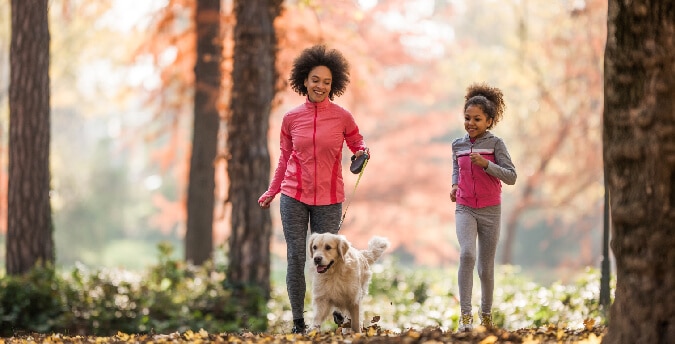Appropriate Amounts of Exercise for Your Dog’s Age

Dogs are a great companion for walks, runs, swims, and any number of aerobic activities, but it should be noted that they vary in their capacity for exercise levels depending on breed, personality, and age. The least obvious of these is age. As a dog gets older, their ability to exercise varies at every stage of their lives. Similar to humans, over or under exercising will have health defects on dogs of all ages, so keep in mind the following information as your dog progresses through his or her life.
PUPPIES AND YOUNG DOGS
These are the most energetic dogs and need the most attention or activity, but a common misconception is to assume that they need extensive and exhausting exercise. Puppies and young dogs are growing, so although their energy level is high, over exercising in formative years can lead to pain, joint problems down the road, or at the very least an exhausted puppy. The best activities for puppies are to play fetch or tug of war with them to keep them moving and excited but not exhaust them. Extremely long hikes or runs may put unnecessary pressure on their joints during their growing years. Moreover, under exercising a puppy is a bad experience for both the dog and its owner. Not only will a puppy without attention be sad and lonely, but also it can lead to health issues as dogs become overweight or weak from lack of exercise. Finally, an under exercised puppy will get quite restless and quite possibly destructive in your home if left without someone to play with, so it’s better for everyone to provide a young dog with adequate play time.
ADULT DOGS
Many breeds of adult dogs can handle more exercise than their humans, as this is the range from about 4-8 years when dogs are fully grown and still have young bodies and full energy. These dogs should be given the most exercise relative to their breeds. This can include long hikes, runs, or whatever fits with your lifestyle. It is difficult to recommend exactly what to do with your adult dog as their main limitations are specific to their breed, so all that should be considered is their specific restrictions. Keep in mind your dog’s personality and limitations and tire them out!
SENIOR DOGS
When a dog approaches its later years, many physical complications increase in prevalence. Their joints are especially prone to wear and tear and this should be accounted for. With that being said, old dogs are still dogs. They want to explore and run around, and don’t know how to limit themselves so the onus is on the owner to control this. Frequent, short walks are great for older dogs as it keeps them mobile and frequently stimulates their minds. An awesome idea for those with senior dogs is to take them swimming more often as they leave their prime years behind. Swimming is great exercise, is fun for most dogs, and has little to no negative impact on their joints. Keep your senior dog active but avoid big hills and long walks or runs to keep them happy and healthy for as long as you can.
